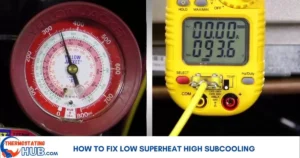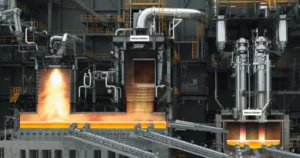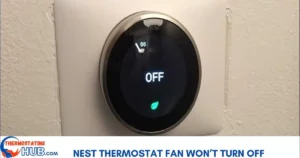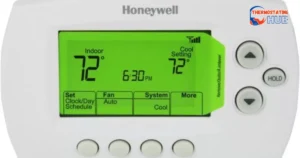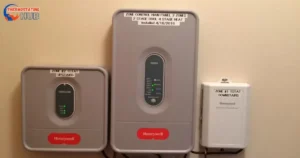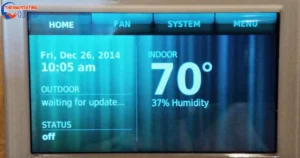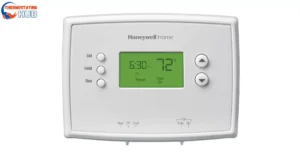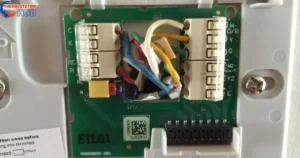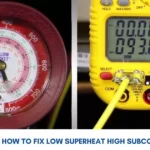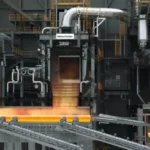Several factors might be at play if your thermostat is set at 74 but insists on showing 78.
Let’s dive into the usual suspects causing this discrepancy, and don’t worry—we’ve got solutions lined up for each issue we uncover.
Typically, when your thermostat is set to a cool 74 but stubbornly displays 78, a variety of culprits could be responsible. These include an active air exchanger, extreme outdoor temperatures, ductwork leaks, a misplaced thermostat, clogged filters, or simply a thermostat begging for a reset.
Now, let’s tackle each one:
Possible reasons why a thermostat reads 78 when it’s set to 74
| Possible Cause | Main Fix |
| The air exchanger not turned off | Turn off the air exchanger |
| Exposed AC unit | Shield AC condenser unit |
| Undersized AC unit | Upgrade AC Unit |
| The thermostat needs a restart/reset | Reset your thermostat |
| Excessive outdoor temperature | Close doors and windows leading outside |
| Leaky ductwork | Seal off leaking ductwork |
| Activate automatic schedules | Deactivate auto-schedules |
| Inappropriate thermostat location | Find a neutral location for your thermostat |
| Power failure to an HVAC system | Reset the tripped circuit breaker |
| Dirty air filters | Replace filter |
| Bad thermostat wiring | Check if the RC wire is connected |
1) The air exchanger is not turned off
Your thermostat acting up, showing 78 degrees when aiming for a more fabulous setting, might be due to a common hiccup—your air exchanger playing hard to get turned off.
Wondering what an air exchanger is? It’s like the mediator between the air inside and outside your home. It brings in the fresh stuff and kicks out the used air.
Now, here’s the twist. While your air conditioner makes things cool, the air exchanger says, “Hold up, let me bring in some fresh air.” The problem is, they’re canceling each other out. The relaxed vibes from the air conditioner clash with the warmth the air exchanger is introducing, and voila—your AC isn’t chilling below 78.
The fix
The simplest and speediest fix for this problem is to turn off the air exchanger and give your AC a spin. If your air exchanger is already off or you don’t have one, yet your thermostat remains stuck at 78 degrees, let’s dive into the next troubleshooting steps.
Pro tip: Ensure your thermostat reflects the indoor climate accurately by keeping external factors like open windows and doors in check. 🌐
2) A thermostat that needs a reset:
It might seem like a no-brainer, but you’d be surprised how many thermostat hiccups a simple reset can fix.
Now, resetting your thermostat is like knowing the secret handshake—it varies based on your make and model. For the lowdown on performing this magical reset, check out the user manual that came with your thermostat.
Pro tip: Keep that user manual handy; it’s like the superhero cape for tackling thermostat mysteries. 📖✨
3) AC unit exposed to sunlight
Enhancing your outdoor AC unit’s efficiency is a breeze—just keep it cool in the shade, away from the harsh sunlight. When the sun’s rays hit that external unit, it soaks up a bunch of heat, making it a tough job for the system to cool your home like a champ. Here’s the 411 on tackling this issue:
Shading the Outdoor Unit:
Build a Shade Fence: Whip up a nifty fence around your outdoor AC unit to shield it from the direct gaze of the sun. Go for lattice work—it gives shade while letting the breeze do its thing. Make sure to position the fence a few feet away so it doesn’t play hide-and-seek with the unit.
Maintain Airflow:
Finding the sweet spot between shade and airflow is key. Too much shade without proper breathing room can cramp your AC’s style. The lattice work fence is a champ at striking this balance.
Additional Tips for Optimal Cooling:
Clean Metal Fins: Show love to the metal fins around your AC unit. Grab a hose with a spray nozzle to wash away dust and debris, giving that airflow the green light.
Sprinkler Cooling: Pull out the sprinkler card when the sun’s throwing its hottest tantrum. Position it to sprinkle a light mist on the AC unit, avoiding a moisture overload. This trick can drop the temperature of the air entering your home by a cool few degrees.
Pro tip: Regularly check and clean those metal fins for a cooling performance that’s always on point. 💨
4) The outdoor temperature is too high
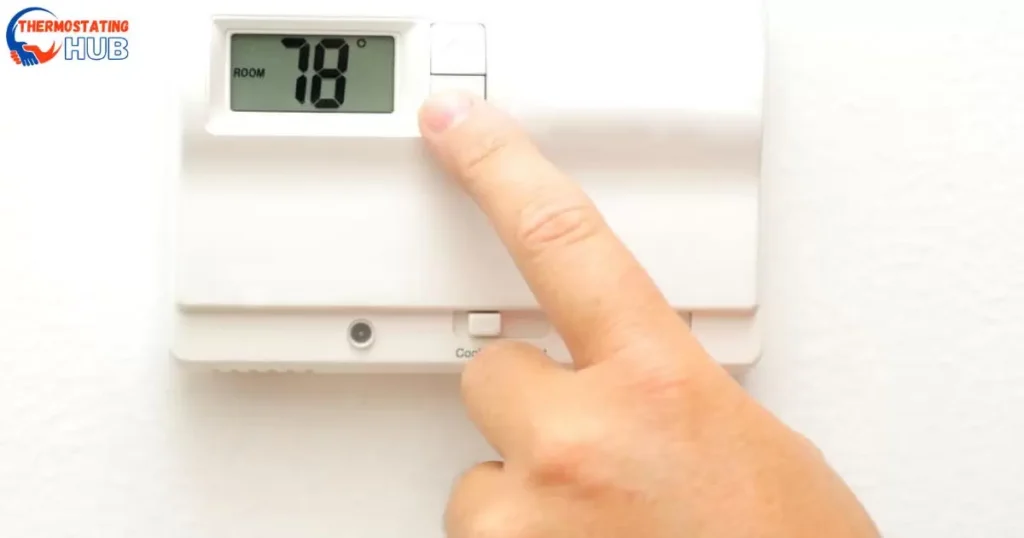
Your thermostat is stuck at 78 instead of the comfy 74 might be pointing fingers at the outdoor temperature and playing hard to cool down. Here’s the lowdown:
Air conditioners are like cool superheroes, but they have limits. They’re designed to bring the indoor air down by a cool 20 degrees from what’s happening outside.
Now, when the outside world throws a blazing 100-degree party, your thermostat can only do so much. It’s like trying to be the hero in an epic heat battle but only managing to cool down to around 80 degrees.
The fix
If you’re in a temperature tussle, a few tricks might help you bring things down a notch.
Turn off the Heat-makers: Give your AC a fighting chance by switching off heat-producing appliances like TVs and stoves. Consider taking the cooking show outdoors with a barbecue or use that handy outdoor kitchen if you’ve got one.
Seal it Up: Keep things airtight by shutting doors and windows that lead to the outside. While your AC is in superhero mode trying to chill your home, letting the heat from outside sneak in is like inviting the enemy to the party—your AC won’t stand a chance to cool to your preferred temperature.
Pro tip: When it’s a cooling showdown, every closed door and turned-off appliance is your ally in the battle against the heat. 🔥🚪
5) Undersized AC Unit
An undersized unit might be the sneaky culprit when your AC is playing hard to cool your space. Here’s the scoop on what’s happening and how to tackle it:
Inadequate Cooling Capacity:
Picture this—an undersized AC unit struggling in a battle against the heat load in your room. It’s like bringing a water pistol to a firefight. Even with the thermostat, the AC runs non-stop but can’t keep up with the heat invasion, leaving the temperature far from your cozy zone.
Solution:
Upgrade to a Properly Sized Unit: Time to call in the HVAC pros. Get them to size up your space and determine the AC unit that packs the right punch. They’ll consider room size, insulation, and heat-making gadgets. Swap that undersized troublemaker for the right-sized hero, and watch the cooling efficiency soar.
Improve Insulation and Seal Leaks:
Give your AC a helping hand by making your space cozy and leak-proof. Insulate well and seal up those windows and doors to reduce the heat sneak attacks. Less heat infiltration means less stress on your AC.
Pro tip: Size matters when it comes to your AC unit—make sure it’s the right fit for your space to keep things cool and comfy. ❄️🌐
6) Leaking ductwork
When your AC is on a mission to cool but falls short of hitting that set temperature, leaking ductwork might be the silent saboteur. The logic is straightforward:
Leaky ducts act like sneaky escape routes for the cooler air. Picture it—cooler air makes a break for it, and the warmer air comes, crashing the cool party. So, when the air reaches your room, it’s like a confused mix of warm and cool, leaving your thermostat hanging at a not-so-chill 74 degrees.
That could be the undercover culprit behind your thermostat, not quite nailing that cool 74.
The fix
Inspect for Leaks: Grab your detective hat and thoroughly check those ducts for leaks, especially around the joints—they’re known troublemakers. Once you spot a leak, seal it up tight. Give your AC a spin and see if that pesky temperature issue takes a hike.
Now, if DIY isn’t your jam or those ducts are playing hide-and-seek:
When in doubt, bring in the experts. Call up the professionals to handle the duct detective work. They’ve got the tools and know-how to spot and seal those sneaky leaks, giving your AC the fighting chance it deserves.
Pro tip: A leak-free duct is like a VIP pass to optimal cooling—whether you’re the hands-on type or prefer the experts, just make those leaks disappear. 🔍🔧
Read also: Why Is My Nest Thermostat Buzzing?
7) Check for active schedules on your thermostat
Thermostats, like some well-behaved guests, might have their plans and not let you tweak the temperature when they’re on an automatic schedule. Here’s a quick check:
Automatic Schedule Lock:
Depending on the brand, your thermostat could play by its own rules. It might not budge on temperature changes if it’s following an automatic schedule.
The fix
If your thermostat is holding on tight to those auto schedules, it’s time to break free and take charge:
Disable Auto Schedule: Navigate through your thermostat settings and look for the auto schedule feature. Turn it off and regain control over your temperature preferences.
Reset for a Fresh Start: A good old reset might do the trick if the auto schedule seems stubborn. Power down your thermostat, give it a moment and bring it back to life. After the reset, check if your temperature-changing powers are restored.
Pro tip: Sometimes a clean slate is all your thermostat needs—disable the auto schedule or reset it to start anew. ♻️
8) Check the location of your thermostat
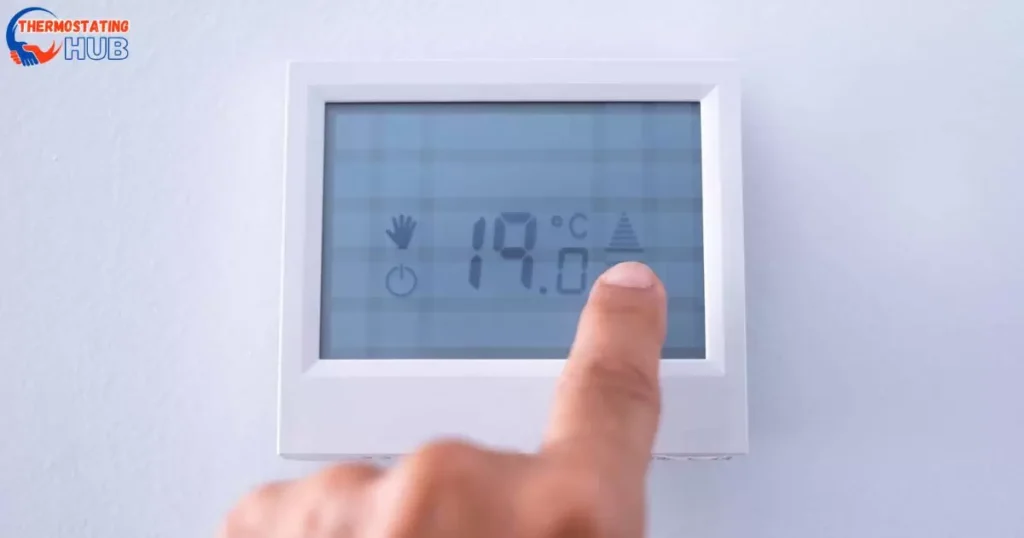
Thermostats are like temperature detectives—sensitive to every move in their surroundings. Where you place them can throw their temperature readings for a loop.
Window Woes: Stick your thermostat near a sun-soaked window, and it might start telling tall tales. The sun’s glare can mess with its readings, leading to unnecessary cooling and a not-so-friendly hike in energy bills.
Vexing Vents: Now, if your thermostat decides to cozy up to the vents, it might get too chill. Recording lower temperatures could leave your home feeling warmer than you’d like.
The fix
If you suspect your thermostat is playing hide-and-seek with accurate readings due to its location, it’s time for relocation dance.
Relocation Tips: Ideally, aim for the first-floor spotlight when finding a new home for your thermostat. This central position gives a more balanced view of your home’s temperature.
Heat-Averse Spots: Keep your thermostat away from heat-emitting maestros like the stove. These appliances can throw off its game and lead to misguided temperature readings.
Vent-Free Zone: Steer clear of vent-heavy areas when picking a new spot for your thermostat. Vents can create temperature turbulence, and we want our thermostat to have a calm and accurate reading environment.
Pro tip: Give your thermostat a VIP spot—first floor, away from the heat, and vent-free for readings that hit the sweet spot. 🏡
9) Power failure to your HVAC system
If your thermostat seems to be stuck on 78, resisting your attempts to set it at an excellent 74, the power supply to your HVAC system might be throwing a party pooper in the mix.
Condenser Conundrum: Picture this—the outdoor condenser unit doing its fantastic dance, using Freon through the coils and a trusty blower fan to kick that heat to the curb. But if this dynamic duo takes a power nap for any reason, your thermostat won’t get the memo to chill.
No Power, No Cool: Whether it’s a power failure or some other mysterious condenser issue, if the outdoor unit isn’t working its magic, your thermostat won’t be able to cool down to your preferred temperature.
The fix
If your outdoor condenser unit seems to be taking a siesta and doesn’t spring to action when you flip the AC switch, it’s time for a quick check.
Outdoor Unit Inspection: Verify if the outdoor condenser unit is doing its thing. There might be a power hiccup if it’s giving you the cold shoulder. Check for tripped circuit breakers and ensure they’re all in the ‘on’ position.
Deeper Dive: If the condenser is still in a no-show mood, it could be dealing with internal issues like a cranky compressor capacitor or a mischievous blower motor. The HVAC maestros best handle these sneaky culprits.
Solution: For the most intricate problems, call in the HVAC technician. They’ve got the tools and know-how to peek under the hood of your condenser unit and diagnose the problem.
Pro tip: Tripped breakers might be the buzzkill when the condenser is on vacation. If that’s false, let the HVAC pros do their magic for a condenser comeback. 🔧
10) Dirty filters
Air filters take center stage in any HVAC system; their impact is no small feat. Overlooking their significance can spell trouble for your entire HVAC setup.
Dirty filters, in particular, are notorious troublemakers. They can throw a wrench into the gears, causing issues. One such problem is the hindrance of your AC’s ability to hit those set temperatures.
In simpler terms, if your thermostat is stuck at a stubborn 78 degrees, dirty filters could be the sneaky culprit behind the scenes.
The fix
Give your filters some attention—they might be the unsung heroes in your thermostat drama.
Filter Check: Take a peek at your filters. If they’ve taken on a dusty persona, it’s time for a change. Dirty filters can spoil your AC’s performance, making it difficult to hit that desired temperature.
Replacement Routine: Remember, air filters aren’t fans of long-term relationships. AC manufacturers often recommend a replacement dance every 1-2 months. So, if your filters are looking a bit too cozy with the dust, it’s a sign to swap them out for fresh ones.
Pro tip: Treat your AC to new filters regularly—it’s like a breath of fresh air for your cooling system. 🔄
11) Check your thermostat wiring
If your thermostat refuses to reach your desired set point, its wiring might throw a tantrum.
Take a peek at the wiring behind the scenes. If there’s a glitch, especially with the RC wire, your cooling dreams might be on hold. The RC wire plays the power game for your cooling system, and if it’s not playing nice or is just loosely connected, you can kiss those cool vibes goodbye.
The fix
Give your thermostat’s wiring a little checkup—it might just need some attention to get back in the game.
Wiring Inspection: Ensure all wires are snugly connected to their rightful terminals. But don’t be shy—give them a gentle tug to ensure they’re not playing loosey-goosey.
RC Wire TLC: If the RC wire looks like it’s been through a dust storm, it’s time for a cleanup. Please scrub it well, then carefully slide it back into its terminal. Try firing up your system again once the wires are snug and sparkling.
Pro tip: Wiring hiccups can be like sneaky gremlins. Give those wires some love; your thermostat might thank you with a perfect temperature reading. 🔧
Optimizing Home Comfort: Expert Advice for Thermostat Maintenance
- Check the Location: Ensure your thermostat is placed away from direct sunlight and vents for accurate temperature readings.
- Filter Focus: Regularly inspect and replace air filters every 1-2 months to keep your AC system performing at its best.
- Condenser Check: Verify the outdoor condenser unit’s activity; if it’s a no-show, check for tripped circuit breakers or call in an HVAC technician for more profound issues.
- Wiring Wellness: Give thermostat wiring a once-over, ensuring tight connections. Clean dirty RC wires for optimal performance.
- Auto Schedule Awareness: Disable automatic schedules if your thermostat is too independent, affecting your desired temperature.
- Relocate Wisely: If necessary, move your thermostat to a central, first-floor location away from heat-emitting appliances.
- Power Play: Investigate power supply issues; a malfunctioning outdoor condenser can hinder your thermostat’s cooling capabilities due to power failure.
- DIY Duct Detective: Check for duct leaks and seal them to prevent the escape of cool air and the intrusion of warm air.
Pro Tip: Regularly clean your thermostat surroundings and keep the area dust-free for accurate temperature readings. ✨
Temperature Troubles: Pros and Cons of Thermostat Readings
| Issue | Pros | Cons |
| Incorrect Location | Easy to adjust once identified. | It can impact comfort and energy efficiency. |
| No major technical issues. | Can impact comfort and energy efficiency. | |
| Dirty or Clogged Filters | Simple maintenance task. | Reduced cooling efficiency. |
| Improved indoor air quality. | Overworks the AC system. | |
| Faulty Condenser Unit | Clear indication of an issue. | Requires professional diagnosis and repair. |
| A clear indication of an issue. | Potential for costly repairs. | |
| Undetected Wiring Issues | Addressing wiring problems enhances performance. | It can be done with minimal cost. |
| Can be done with minimal cost. | Incorrect handling can lead to more problems. | |
| Automatic Schedule Lock | Energy savings when schedules align with usage. | Limited flexibility in adjusting temperatures. |
| Consistent temperature control. | It may require professional expertise. | |
| Inadequate Thermostat Location | Simple relocation improves accuracy. | Impact on temperature readings and efficiency. |
| Enhances overall HVAC system performance. | Requires adjustment and recalibration. | |
| Power Supply Issues | Identifies potential causes for cooling issues. | It can result in downtime and discomfort. |
| Resolving power problems improves efficiency. | It may require professional duct sealing. | |
| Duct Leaks | Identifies common issues affecting cooling. | This may lead to discomfort if schedules conflict. |
| Improved overall cooling efficiency. | Potential for increased energy bills. |
Pro Tip: Regular thermostat maintenance and prompt issue resolution provide consistent comfort and energy efficiency.
Thermostat Woes Unveiled: Key Takeaways for Improved Comfort
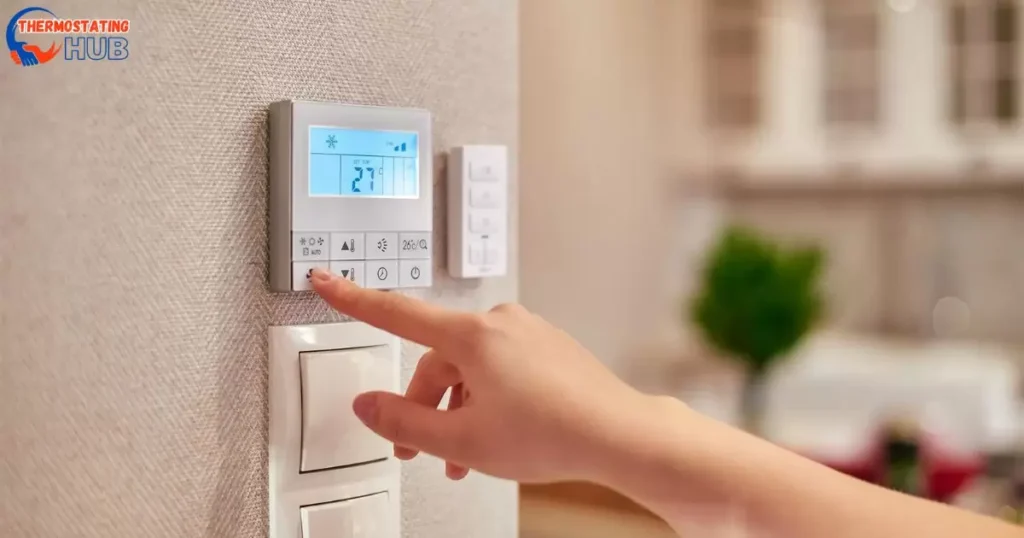
Location Matters:
Ensure your thermostat sits in a prime spot away from direct sunlight and vents. This slight adjustment can make a big difference in accurate temperature readings.
Filter Check-Up:
Regularly inspect and replace air filters to keep your AC system breathing easily. This simple task improves efficiency and maintains good indoor air quality.
Condenser Conundrum:
If your outdoor unit is playing hide-and-seek, check for tripped breakers. For deeper issues, call in HVAC pros to ensure your condenser is in top-notch shape.
Wiring Wellness:
Give your thermostat’s wiring some attention. Tight connections and a clean RC wire prevent temperature troubles and keep your system running smoothly.
Auto Schedule Awareness:
Disable automatic schedules if your thermostat seems to have a mind. Take back control to achieve your desired comfort level.
Relocate for Comfort:
Consider moving your thermostat to a central, first-floor location away from heat-emitting appliances. Finding the right spot enhances accuracy and overall HVAC efficiency.
Power Play:
Investigate power supply issues if your thermostat is stuck at an undesirable temperature. Addressing these can revitalize your HVAC system’s cooling capabilities.
Duct Detective DIY:
Inspect and seal duct leaks to prevent cool air from escaping and warm air from intruding. A DIY fix for better efficiency.
Pro Tip: Regular thermostat TLC and proactive issue resolution are the keys to a consistently comfortable and energy-efficient home.✨
Answers To Key Questions
Why is my AC set at 74 but reads 78?
Possible issues like an air exchanger running or exposure to excessive outdoor temperatures can cause a discrepancy between your set temperature of 74 and the thermostat reading of 78.
Why is my AC thermostat reading higher than setting?
Various factors, such as a misplaced thermostat, dirty filters, or an undersized AC unit, can raise your thermostat reading above the set temperature of 74.
Why is my thermostat not reading the correct temperature?
The thermostat might not be reading the correct temperature due to its location, exposure to sunlight, or the presence of heat-generating appliances. Consider relocating it for better accuracy.
Why is my thermostat not reaching the set temperature?
Reasons like malfunctioning air exchangers, leaking ductwork, or an undersized AC unit may prevent your thermostat from reaching the desired set temperature of 74. Addressing these issues can improve performance.
Final Thoughts
While additional factors may contribute to your thermostat reading 78 instead of the desired 74 degrees, the abovementioned ones are the most prevalent culprits.
As a recurring suggestion, when troubleshooting becomes a challenge, or if you prefer expert hands, reaching out to HVAC professionals is the wise course of action. They possess the knowledge and experience to diagnose and resolve complex issues, ensuring your thermostat and HVAC system operate at their best.
Thank you for taking the time to read this article! If you have any additional questions or need further assistance, please don’t hesitate to ask. I appreciate your engagement! 📚😊

I’m James Wilson, your HVAC maestro from “Thermostating Hub.” Elevate your comfort with my expertise in heating, ventilation, and air conditioning. Let’s transform your space into a haven of perfect temperatures, tackling HVAC issues with precision and enthusiasm.
![The Thermostat Set To 74 But Reads 78 [Causes & Fixes]](https://thermostatinghub.com/wp-content/uploads/2023/12/the-thermostat-set-to-74-but-reads-78.webp)



